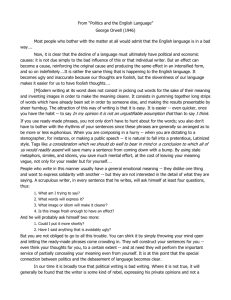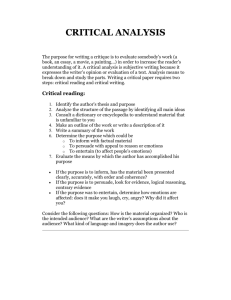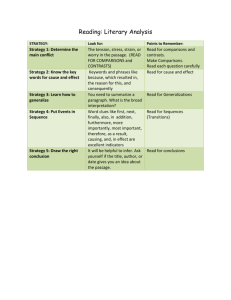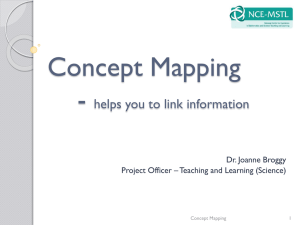Understanding Using Your Own Words All understanding questions
advertisement
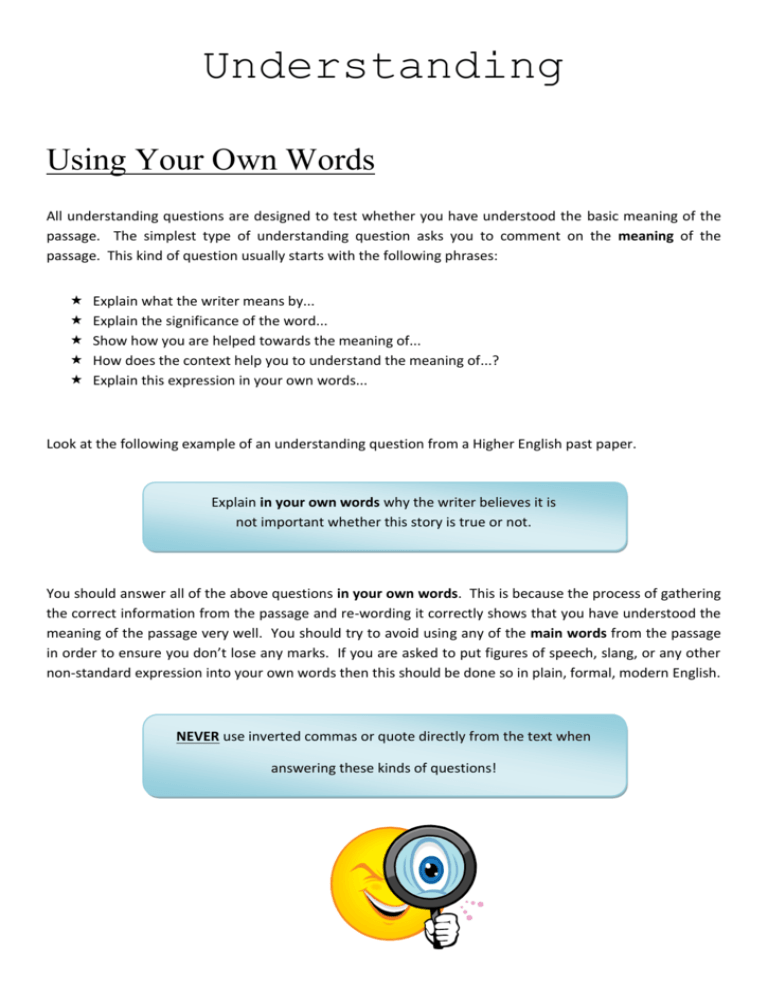
Understanding Using Your Own Words All understanding questions are designed to test whether you have understood the basic meaning of the passage. The simplest type of understanding question asks you to comment on the meaning of the passage. This kind of question usually starts with the following phrases: Explain what the writer means by... Explain the significance of the word... Show how you are helped towards the meaning of... How does the context help you to understand the meaning of...? Explain this expression in your own words... Look at the following example of an understanding question from a Higher English past paper. Explain in your own words why the writer believes it is not important whether this story is true or not. You should answer all of the above questions in your own words. This is because the process of gathering the correct information from the passage and re-wording it correctly shows that you have understood the meaning of the passage very well. You should try to avoid using any of the main words from the passage in order to ensure you don’t lose any marks. If you are asked to put figures of speech, slang, or any other non-standard expression into your own words then this should be done so in plain, formal, modern English. NEVER use inverted commas or quote directly from the text when answering these kinds of questions! Example for you to try... The internet search engine Google, with whom I spend more time than with my loved ones, is planning to put the contents of the world’s greatest university libraries online, including the Bodleian in Oxford and those of Harvard and Sanford in America. Part of me is ecstatic at the thought of all that information at my fingertips; another part of me is nostalgic because I think physical libraries, book lined and cathedral-quiet, are a cherished part of civilisation we lose at our cultural peril. What two contrasting emotions does the writer have about the plan to put the great university libraries online? Use your own words in your answer. 2U Identifying Points The second type of understanding question that you will encounter when completing a close reading passage is one that asks you to identify points. This kind of question is the most straightforward and usually includes phrases such as: What are the three reasons for...? What four things, in their view, do they expect...? What three main reasons does the writer give for...? Identify two similarities between... These kinds of questions are very similar to the previous ones as you are still being asked to pick out points from the passage and explain them. Similarly, to gain full marks in these questions you should not quote from the passage, but answer in your own words as far as possible. This is because it is still your understanding of the passage that is being assessed and the only way to show that you have understood what you have read is to answer the question in your own words. Worked Example The urge to write may also be the fear of death – particularly with autobiography – the need to leave messages for those who come after, saying, ‘I was here; I saw it too’. Then there are the other uses of autobiography, some more utilitarian than others – exposure, confession, revenge. In writing my first volume of autobiography ‘Cider with Rosie’, I was moved by several of these needs, but the chief one was celebration: to praise the life I’d had and so preserve it. What three main reasons does Laurie Lee give for writing autobiography in lines 1 – 6? 3U Right away you should be able to identify that the three reasons are: To record history or personal experience in some way. To use the autobiography to settle old scores or to justify oneself. To tell everyone about the joyfulness of his life, and/or to remind himself about it. In this answer, if you chose to translate ‘exposure’, ‘confession’ and ‘revenge’ you would only get one mark. Technically you are right – these are three reasons for writing autobiography but there are two clues in the question which show you that this is not the whole answer. The first clue is ‘three main reasons’ and the second is ‘in lines 1-6’. Firstly, this tells you that you are looking for the three reasons that are most important to the author making the last reason – ‘the chief one’ – one of the three you should focus on. Secondly, when the question asks you to look at lines 1-6 you should make sure that you look at the whole of that section. If the answer the examiner was looking for was only taken from the one line, then you would only be asked to concentrate on that one line, not all six! Example for you to try... It may well be that public demand and technical change mean we are no longer need the dense neighbourhood network of local libraries of yore. But our culture, local and universal, does demand strategically situated libraries where one can find the material that is too expensive for the ordinary person to buy, or too complex to find online. Such facilities are worth funding publicly because the return in informed citizenship and civic pride is far in excess of the money spent. Libraries also have that undervalued resource – the trained librarian. The ultimate Achilles’ heel of the internet is that presents every page of information as being equally valid, which is of course nonsense. The internet is cluttered with false information, or just plain junk. The library, with its collection honed and developed by experts, is a guarantee of the quality and veracity of the information contained therein, something that Google can never provide. In your own words as far as possible, give four reasons the writer presents in favour of maintaining traditional public libraries. 4U Context Questions Another common type of understanding question is the context question. Here you are asked firstly to explain the meaning of a particular word or phrase and secondly to explain how you arrived at this meaning by reading the sentences surrounding it. These questions usually look like this: Show how the context helps you to arrive at the meaning of... Show how this sentence provides a context which enables you to understand the meaning of... By referring closely to lines 1-6, show how you are helped to understand the meaning of... How does the context in which it is used help you to understand the meaning of...? The most effective method of tackling these types of questions involves using your own words to explain the meaning of the word or phrase and then describing how the surrounding sentences helped you to work out that meaning. This is one of the rare times when you can quote the words or phrases in your answer that provide the clues to the meaning but you can only use these quotes as evidence to support your point. Worked Example I recently found myself unimpressed by some visiting American who stunned me with monstrous verbosity, determined to use five words where one would do, bent on calling a canteen an ‘in-plant feeding station’ and a spade ‘a primitive earth-breaking implement’. Show how the context of ‘monstrous verbosity’ helps you to arrive at its meaning. 2U In this example, it is quite easy to figure out what ‘monstrous verbosity’ means as, after the writer has used the expression, he goes on to describe what he means by it. ‘Five words where one would do’ shows that the American uses far too many words in his sentences hence providing an explanation of what ‘verbosity’ means. The writer then goes on to give examples such as ‘in-plant feeding station’. Therefore, a correct answer would be: ‘Monstrous verbosity’ means an appalling number of worthless words. ‘Five words when one would do’ shows that the American used too many words in his sentences and the writer uses the word monstrous to show how appalled he was by this. Phrases quoted such as, ‘in-plant feeding station’ shows how pointless the words are. Note how the quotes are used in this answer. These quotes are used as evidence – not as part of the answer. For example it would not be acceptable to write, ‘monstrous verbosity’ means using ‘five words when one would do’. Example for you to try... Others are, however, convinced that it is only a matter of time before we face Armageddon. Liberal Democrat MP and sky-watcher, Lembit Opik, says: “I have said for years that the chance of an asteroid impact which cloud wipe out most of the human race is 100 percent.” He has raised his worries in the Commons, successfully campaigned for an all-party task force to assess the potential risk and helped set up the Spaceguard UK facility to track near-earth objects. He admits: “It does sound like a science fiction story and I may sound like one of those guys who walk up and down with a sandwich-board saying the end of the world is nigh. But the end is nigh.” Show how this paragraph helps you to understand the meaning of the word “Armageddon”. 2U Linking Questions By far, the most feared of the understanding questions is the linking question. There is no reason to let this kind of question intimidate you because as long as you know how to tackle them then they are really easy! These questions are just another way of testing your understanding of the passage as well as your appreciation of the structure of the text. You will be asked show how one sentence provides a link in the writer’s argument. Here are some examples of link questions: Explain how this sentence acts as a link between the first and second paragraph. Show how the sentence performs a linking function in the writer’s line of thought. Referring to specific words of phrases, explain how the sentence acts as a link in the writer’s line of thought. Usually (but not always) the linking sentence will stand at the beginning of the paragraph. Part of the sentence will refer back to the previous topic and another part will introduce the new topic which follows. Such questions are normally worth two marks – one for identifying the parts of the sentence which link back and forward and one for identifying the topics which it connects. Worked Example This week the Home secretary was assuring his French counterpart that Britain would clamp down even more severely on those working here illegally. At the same time plans are advanced for “accommodation centres” which will have the immediate effect of preventing natural integration, while children of immigrants are to be denied the harmonising effect of inter-racial schooling. Yet at the heart of this ever more draconian approach to immigration policy lie a number of misconceptions. The UK is not a group of nations swamped by a tidal wave of immigration. Relatively speaking, Europe contends with a trickle of refugees compared with countries who border areas of famine, desperate poverty, or violent political upheaval. Referring to specific words or phrases, show how the sentence “Yet ... misconceptions” performs a linking function in the writer’s line of thought. 2U There is a four step process that you can follow to answer every linking question: Identify the linking sentence. Identify two words or phrases in the linking sentence, one pointing back and one pointing forward in the writer’s argument. Link the backward pointing word or phrase to a previous point in the paragraph. Link the forward pointing word or phrase to the relevant points in the following paragraph. In this example the first step is done for you as the question identifies the linking sentence “yet ... misconceptions”. The second thing you should do is identify the linking words. Backward linking words are usually either determiners – words like ‘this’ or ‘that’ – or conjunctions – words like ‘but’ or ‘however’. From this, we can identify that the backwards linking phrase is ‘this ever more draconian approach’ because it refers to the government’s position mentioned in the previous paragraph. The forward linking phrase is ‘a number of misconceptions’. We can tell this because the writer does not give any information about these misconceptions, so the only option is to provide an explanation in the sentences that follow. Here is an exemplar answer that would be awarded full marks: ‘This ever more draconian approach’ refers back to the harsh measures which are to be taken against immigrants mentioned in the first paragraph. The ‘number of misconceptions’ are illustrated in the rest of the paragraph where it talks about the mistakes that people make in their assumptions. The parts highlighted in bold are the sections that would be awarded the marks – one for identifying both linking phrases and one for explaining what they link to. Example for you to try... The problem here is political will rather than financial capacity. The pinch will come in other resource areas, such as health spending. People over 65 consume three times as many prescription items as other age groups. Nearly half of those with some measure of disability are over 70. But the resource question, meeting the material needs of the old and elderly, is only half the story. The real problem lies elsewhere – in the imagination. What are the old for? Who are they, and do traditional divisions of human life into childhood, youth, middle-age and old-age still fit our experience? Referring to specific words or phrases, explain how the sentence “But ... story” acts as a link in the writer’s line of though. 2U Summary Make sure that when you answer understanding questions that you do so in your own words and do not quote directly from the passage. Take note of the particular section of the passage that you are asked to focus on – if the question asks you to look at lines 20-30 then your answer should include points from that whole section. Similarly, there is nothing worse than writing a fantastic detailed answer only to discover later that you have gone too far ahead in the passage and only half of it is relevant. Use your own words at all times. Even if the question does not include the line, ‘in your own words’ you are expected to do it anyway. If you simply lift chunks out of the passage, you won’t get any marks at all! If you are asked to consider the context of a particular word or phrase you must give both the meaning of the phrase and explain how the surrounding words or sentences (the context) helped you to understand what the phrase meant. In this case you are allowed to quote words or phrases from the text but only to provide evidence! Remember that link questions can be answered by the four step process mentioned above.



